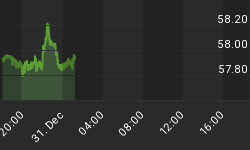Bonds did bounce nicely from just under 114 on the Long Bond Future as forecasted. The Treasury bond auctions during the course of the week provided mixed information for the market, but most importantly the last tranche, the 10 year auction, was very well received and sparked a rally. The Fed raised its overnight rate to 3.50% as expected, but that did not impact the long end of the maturity spectrum. The yield curve continues to flatten, as there is less than 100 basis points difference between overnight and 30 year rates. The difference between 2 and 10 year Treasuries is now less than a quarter of 1%. I reckon by year-end the Fed should manage to engineer at least a flat - if not an inverted - yield curve. For a little while US 10 year yields popped above the level that UK 10 year bonds were trading, temporarily making US Treasuries the high-yielder in the G7 government bond arena. And that includes such "low-yielding" stalwarts as Italian and Canadian bonds. The bottom line is that the flattening yield curve will cause increasing stress for consumers - in the form of increasing short term rates - as well as financial institutions - in the form of a dwindling carry trade - and US long bonds are dirt cheap relative to their counterparts worldwide. These dynamics should provide ongoing support for the long dated US Treasury bond issues.
NOTEWORTHY: In contrast to the recent past, the economic data was disappointing last week. Retail Sales were lower than the high expectations that near-record auto sales have built in, the US Trade Deficit topped consensus, while the Michigan Consumer Confidence Index surprisingly declined in spite of a slew of good news during the past month or so. Rumour has it that CondoFlip.com was down for an hour, which must have artificially depressed the data. On the other hand, maybe someone is actually paying some attention to energy prices going through the roof. The upcoming week's schedule includes the inflation reports - which are expected to continue to surprise to the downside - more consumer and industrial surveys, housing numbers, industrial production data, a little something for everyone to enjoy.
INFLUENCES: The latest Treasury market survey of all the Wall Street gurus is still predominantly bearish. The 'smart money' commercials are still positive on the 10 year note futures, their positions are essentially the same as last week, long 122k. This number is slightly positive for bonds. Seasonals are choppy this week, but becoming quite positive right through to the end of September starting next week. Bonds had a weekly outside reversal to the upside last week. The Long Bond Futures traded down to 113-24 on Tuesday around Fed-time, then they promptly rallied for the rest of the week. I certainly hope all you little bond traders out there in bond-land got a chance to load up on some cheap Treasury bonds last week.
RATES: US Long Bond futures closed at 115-31, up close to two dollars this past week, while the yield on the US 10-year note decreased 15 basis points to 4.24%. The Canada - US 10 year spread was in 12 to -27 basis points as Canadian bond market participants are finally realizing that Canadian bonds are rather expensive relative to their US counterparts. The US-Canada 10 year yield spread did not quite trade to our targeted pick-up of 46 basis points or better last week, and it looks like we got a little too greedy on our target on this trade. The belly of the Canadian curve outperformed 4 basis points relative to the wings last week. Selling Canada 3.25% 12/2006 and Canada 5.75% 6/2033 to buy Canada 5.25% 6/2012 was at a pick-up of 33 basis points. Assuming an unchanged curve, considering a 3-month time horizon, the total return (including roll-down) for the Canada bonds maturing in 2012 and 2013 are the best value on the curve. In the long end, the Canada 8% bonds maturing on June 1, 2023 continue to be the cheapest issue on a relative basis. I have been an ongoing fan of curve flatteners as well as investing in the mid-term maturity issues (a.k.a. the carry-in-the-belly) versus the long and short term maturity bonds. Both these trades have come a long way, and tend to overshoot a great deal. They have moved past their long term averages, but the trend seems to keep these dynamics in motion. While the yield curve flattening trade has been over-crowded for a while, the belly versus the wings trade is still far from popular. I am looking for these trends to stay in motion for the foreseeable future.
CORPORATES: Corporate bond spreads were steady again last week. Long TransCanada Pipeline bonds were unchanged at 116, while long Ontario bonds were also stable at 44.5. A starter short in TRAPs was recommended at 102 in February 2004. Shorter maturity, quality corporates should be favoured over lower rated issues as I believe corporate spreads will continue to be under pressure. Any credit that is connected with the consumer and discretionary spending should be avoided. As a new recommendation we advised to sell 10 year Canadian Bank sub-debt at a spread of 58 bps over the 10 year Canada bond. This spread closed at 54 basis points on Friday - unchanged on the week.
BOTTOM LINE: We recommended buying bonds on dips to the 114 level on the Long Bond future. We are officially long the market at this point. The sell Canada 10 year bonds to buy US 10 year notes at 46 bps or better trade is still pending, we will not chase it at this point. An overweight position in the belly of the curve is still recommended for Canadian accounts. Short exposure for the corporate sector is advised. We recommended an increase in short corporate exposure recently.
















